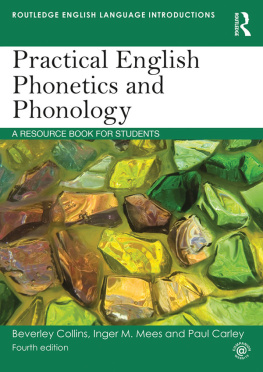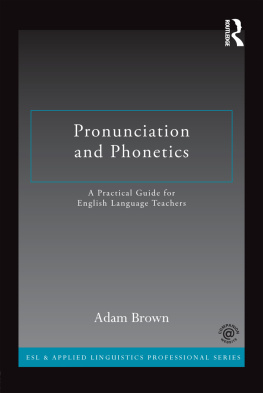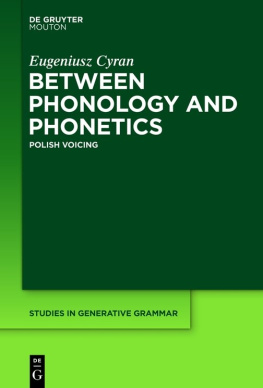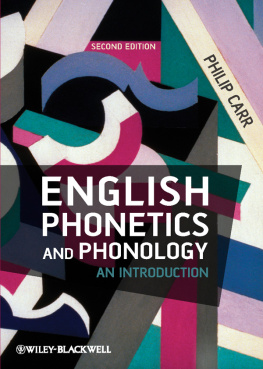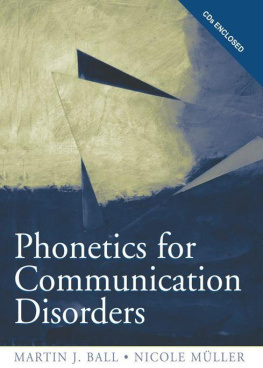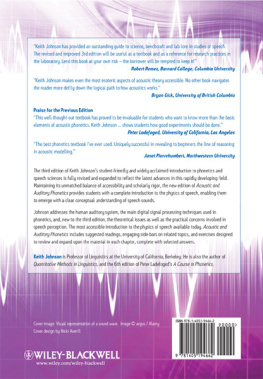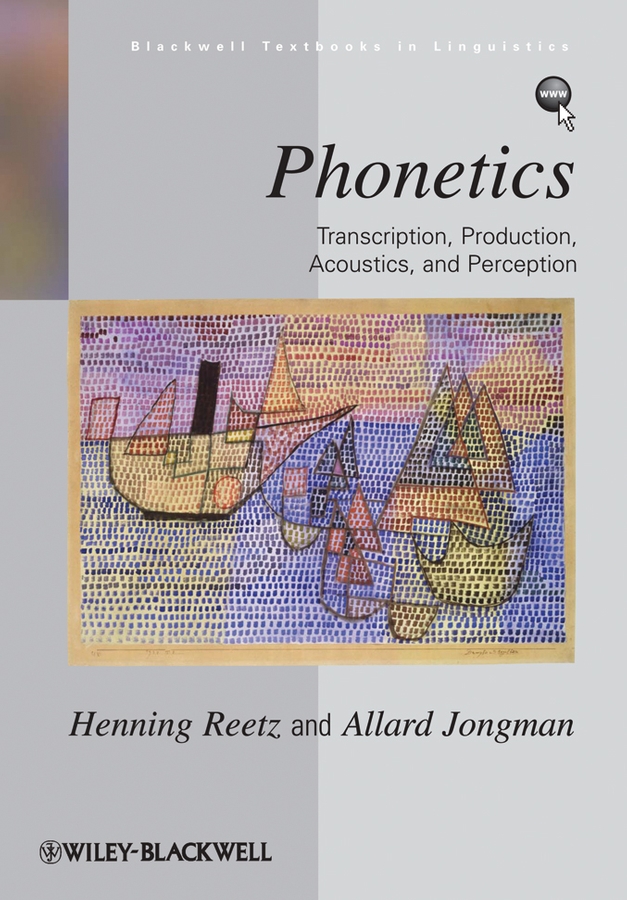
Blackwell Textbooks in Linguistics
The books included in this series provide comprehensive accounts of some of the most central and most rapidly developing areas of research in linguistics. Intended primarily for introductory and post-introductory students, they include exercises, discussion points and suggestions for further reading.
1. Liliane Haegeman, Introduction to Government and Binding Theory (Second Edition)
2. Andrew Spencer, Morphological Theory
3. Helen Goodluck, Language Acquisition
4. Ronald Wardhaugh, An Introduction to Sociolinguistics (Fifth Edition)
5. Martin Atkinson, Childrens Syntax
6. Diane Blakemore, Understanding Utterances
7. Michael Kenstowicz, Phonology in Generative Grammar
8. Deborah Schiffrin, Approaches to Discourse
9. John Clark, Colin Yallop, and Janet Fletcher, An Introduction to Phonetics and Phonology (Third Edition)
10. Natsuko Tsujimura, An Introduction to Japanese Linguistics (Second Edition)
11. Robert D. Borsley, Modern Phrase Structure Grammar
12. Nigel Fabb, Linguistics and Literature
13. Irene Heim and Angelika Kratzer, Semantics in Generative Grammar
14. Liliane Haegeman and Jacqueline Guron, English Grammar: A GenerativePerspective
15. Stephen Crain and Diane Lillo-Martin, An Introduction to Linguistic Theoryand Language Acquisition
16. Joan Bresnan, Lexical-Functional Syntax
17. Barbara A. Fennell, A History of English: A Sociolinguistic Approach
18. Henry Rogers, Writing Systems: A Linguistic Approach
19. Benjamin W. Fortson IV, Indo-European Language and Culture: AnIntroduction
20. Liliane Haegeman, Thinking Syntactically: A Guide to Argumentation andAnalysis
21. Mark Hale, Historical Linguistics: Theory and Method
22. Henning Reetz and Allard Jongman, Phonetics: Transcription, Production,Acoustics, and Perception

This edition first published 2009
Henning Reetz and Allard Jongman
Blackwell Publishing was acquired by John Wiley & Sons in February 2007. Blackwells publishing program has been merged with Wileys global Scientific, Technical, and Medical business to form Wiley-Blackwell.
Registered Office
John Wiley & Sons Ltd, The Atrium, Southern Gate, Chichester, West Sussex, PO19 8SQ, United Kingdom
Editorial Offices
350 Main Street, Malden, MA 02148-5020, USA
9600 Garsington Road, Oxford, OX4 2DQ, UK
The Atrium, Southern Gate, Chichester, West Sussex, PO19 8SQ, UK
For details of our global editorial offices, for customer services, and for information about how to apply for permission to reuse the copyright material in this book please see our website at www.wiley.com/wiley-blackwell.
The right of Henning Reetz and Allard Jongman to be identified as the authors of this work has been asserted in accordance with the Copyright, Designs and Patents Act 1988.
All rights reserved. No part of this publication may be reproduced, stored in a retrieval system, or transmitted, in any form or by any means, electronic, mechanical, photocopying, recording or otherwise, except as permitted by the UK Copyright, Designs and Patents Act 1988, without the prior permission of the publisher.
Wiley also publishes its books in a variety of electronic formats. Some content that appears in print may not be available in electronic books.
Designations used by companies to distinguish their products are often claimed as trademarks. All brand names and product names used in this book are trade names, service marks, trademarks or registered trademarks of their respective owners. The publisher is not associated with any product or vendor mentioned in this book. This publication is designed to provide accurate and authoritative information in regard to the subject matter covered. It is sold on the understanding that the publisher is not engaged in rendering professional services. If professional advice or other expert assistance is required, the services of a competent professional should be sought.
Library of Congress Cataloging-in-Publication Data
Reetz, Henning.
Phonetics : transcription, production, acoustics and perception / Henning Reetz and Allard Jongman.
p. cm. (Blackwell textbooks in linguistics ; 22)
Includes bibliographical references and index.
ISBN 978-0-631-23225-4 (hardcover : alk. paper) ISBN 978-0-631-23226-1
(pbk. : alk. paper) 1. Phonetics. 2. Speech. I. Jongman, Allard. II. Title.
P221.R37 2009
414.8dc22
2007052357
Preface
Phonetics is traditionally subdivided into three areas: articulatory phonetics concerns the way in which speech is produced and requires an understanding of the physiology of the speaking apparatus; acoustic phonetics investigates the acoustic characteristics of speech such as frequency, intensity, and duration, and requires knowledge of sound waves; auditory phonetics addresses the perception of speech and requires awareness of the function of the auditory system and memory. Phonetics thus spans several related disciplines, including linguistics, biology, physics, and psychology. In addition, students of phonetics should be familiar with phonetic transcription, the use of a set of symbols to write speech sounds.
Some courses in phonetics cover primarily articulatory phonetics and phonetic transcription while others focus on acoustic or auditory phonetics. However, in our teaching experience, we have found it more rewarding to combine these subjects in a single course. For example, certain speech patterns are better explained from an articulatory point of view while others may be more readily motivated in terms of auditory factors. For these reasons, we decided to write this textbook.
This book covers in detail all four areas that comprise phonetics: articulatory, acoustic, and auditory phonetics as well as phonetic transcription. It is aimed at students of speech from a variety of disciplines (including linguistics, speech pathology, audiology, psychology, and electrical engineering). While it is meant as an introductory course, many areas of phonetics are discussed in more detail than is typically the case for an introductory text. Depending on their purpose, readers (and instructors) will probably differ in terms of the amount of detail they require. Due to the books step-wise approach, later chapters are accessible even if sections (for example, those containing too much technical detail) of preceding chapters are skipped. While some technical detail is, of course, inevitable (for example, to understand a spectrogram), little knowledge of physics or mathematics beyond the high school level is required. Technical concepts are introduced with many examples. In addition, more advanced technical information can be found in Appendices A amd B in order to maintain a readable text. This book thus employs a modular format to provide comprehensive coverage of all areas of phonetics with sufficient detail to challenge to a deeper understanding of this complex interdisciplinary subject.
Phonetics as a science of speech should not be geared toward any particular language. Nonetheless, many examples in this textbook are from English, simply because this book is written in English. We do, however, include examples from a variety of languages to illustrate facts not found in English, but in-depth knowledge of those languages by the reader is not required.
Next page

